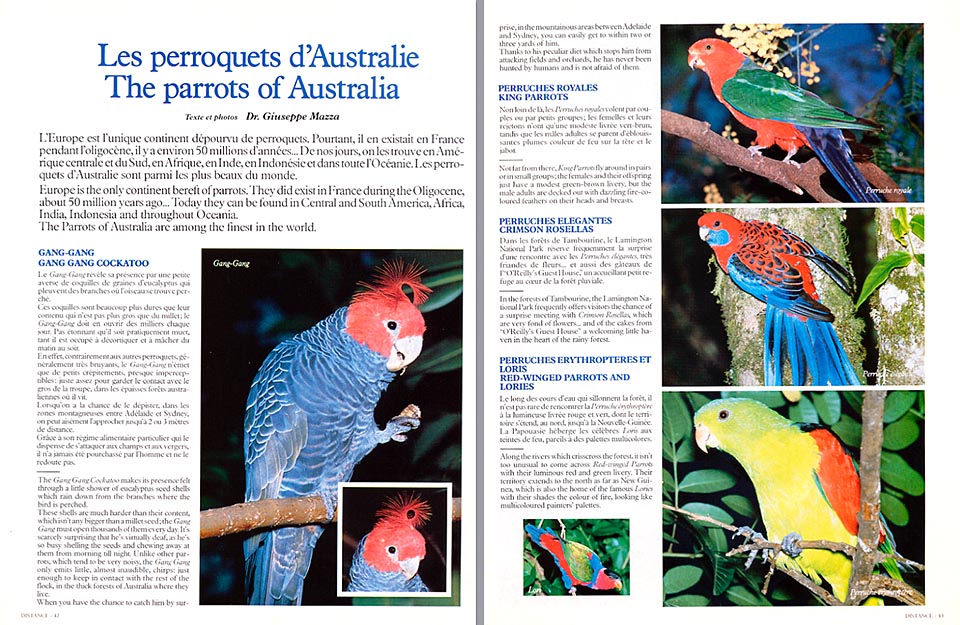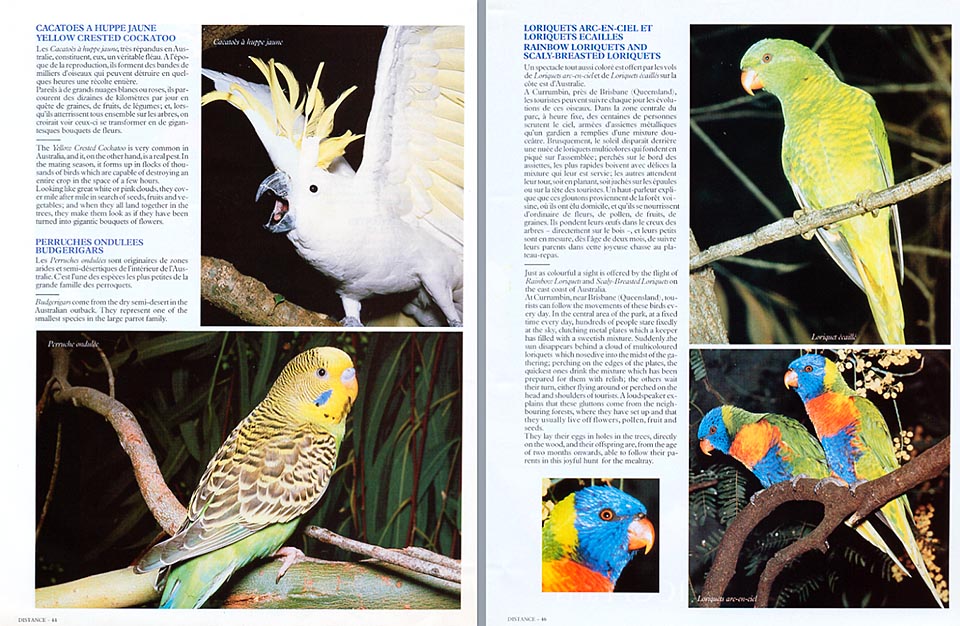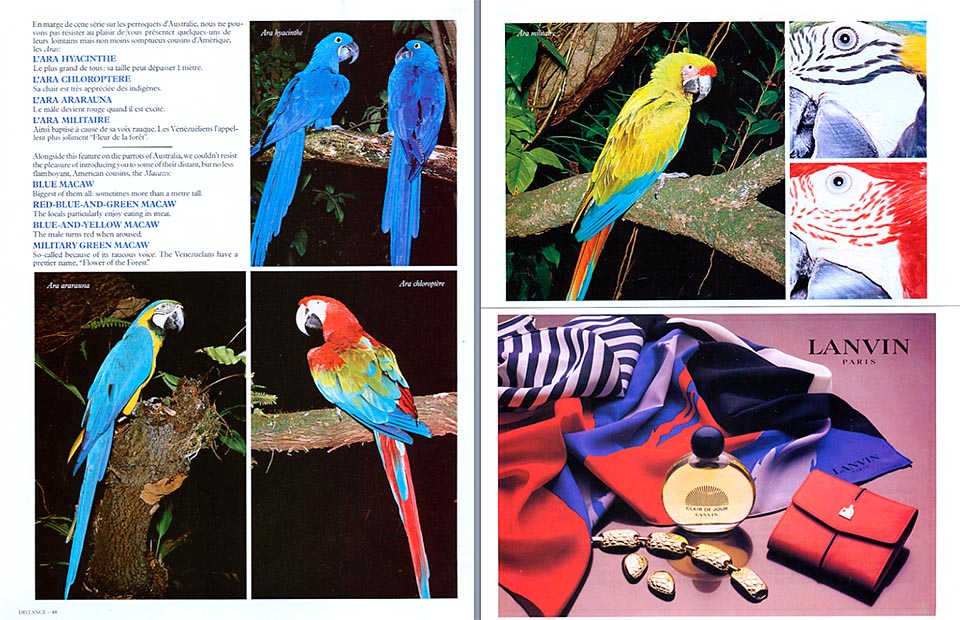Australian parrots and their large South American relatives. A colourful report for the on-board journal of the French air company UTA.



English translation by Mario Beltramini

Europe is the only continent lacking of parrots. They were there during the oligocene, about 50 millions of years ago, but, nowadays, they are found only in Centre-South America, Africa, India, Indonesia, and in the entire Oceania. The Australian ones are the most beautiful. Let us see some of them.
Gang-gang cockatoo (Callocephalus fimbriatum)
It reveals often its presence with a light rain of shells of eucalyptus seeds, which fall down, insistently, from the trees where it’s placed. The shells are much harder than their contents, which is smaller than a seed of millet, and the gang-gangs, in order to nourish themselves, have to open thousands of them, every day. We must not be surprised, then, that they are almost dumb, busy as they are, in skinning and chewing seeds the whole day round.
Indeed, contrary to other parrots, mostly noisy, the gang-gang emits only light cracklings, almost imperceptible, just to keep the contact with the group in the thick forests where it lives.
When you have the luck to meet it, in the mountain areas between Adelaide and Sydney, you can usually approach it till 2-3 metres. Thanks to the particular alimentary diet, which keeps it far away from fields and orchards, it has never been chased by man…. and therefore it does not fear him.
Australian king parrot (Alisterus scapularis)
They fly in small groups or in pairs. The females and immature young specimen have an unassuming green and brown livery, while adult males display sparkling fiery red plumes on the head and the abdomen, with green wings and a blue tail.
Crimson rosella (Platycercus elegans)
In the forest of Tambourine, in Lamington National Park, it’s easy to come across the Crimson rosellas. They are greedy of the flowers of the forest and… the sweets offered by the tourists, guests of the “O’Reillys’s Guest House”, a small welcoming refuge in the heart of the rainy forest.
Red-winged parrot (Aprosmictus erythropterus), and Black-capped lory (Lorius Lory)
Along the water courses which pass through the forest, it is also possible to meet the red-winged parrot, with a bright green and red livery. Its distribution area extends northward till New Guinea. Papua gives hospitality to the famous Lories, with their even more showy colours.
Sulphur-crested cockatoo (Kakatoe galerita)
Very much spread out in Australia, the sulphur-crested cockatoos are a real calamity. At the time of the reproduction, they meet by thousands… and during their raids, they can destroy a harvest in few hours.
They go through, like white clouds, tens of kilometres per day, looking for seeds, fruits, and vegetables, and, when they land all together on a tree, this one could be thought to be an enormous bunch of flowers.
Budgerigar (Melopsittacus undulates)
The well known common pet parakeet, is native from the arid and semi desert areas of the centre of Australia.
Rainbow lorikeet (Trichoglossus haematodus) and Scaly-breasted lorikeet (Trichoglossus chlorolepidotus)
At Currumbin, near Brisbane, Queensland, on the eastern coast of Australia, the tourists can be present, every day, at spectacular multicoloured flights of the lorikeets, thousands of them.
In the central zone of the park, at fixed timings, hundreds of persons stare the sky, holding with a hand small metallic plates containing a “sweetish soup”. Suddenly, the sun disappears behind a cloud of multicoloured parrots, which come down, nosedive. They land on the border of the plates, drink eagerly the wishy-washy soup the keepers have prepared, while, for want of room, the others try to land or wait for their turn, on the shoulders or the heads of the tourists.
A loudspeaker explains that they are coming from a close by forest, and that in nature, they feed of flowers rich of nectar, fruits, and seeds. They nidify in the hollows of the trees, laying the eggs directly on the wood.. and that, when two months old, the young are already able to join their parents in the animated “small plates hunting”.
The American relatives
In America, Macaws, the “giants” in the world of parrots, are also spectacular and colourful. Species like the Hyacinth macaw (Anodorhynchus hyacinthinus), which is more than one metre long, the Green-winged macaw (Ara chloroptera), more coloured than a painter’s palette, the Blue-and-yellow macaw (Ara ararauna), with males so ardent to get the cheeks red coloured, and the Military macaw (Ara militaris), in green uniform with the “red cap”, and a very unpleasant “barracks’ voice”.
© Giuseppe Mazza
The reproduction, even partial, of the text
and the photos without the Author’s written permission is forbidden.
